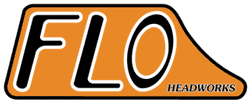 |
FLO Headworks: |
|
|
|
| |||||||||||||||
|
When
your Harley makes its power in the orange band,
|
|
|
Are you like a lot of motorcycle owners,
paying close attention to maximum horsepower and torque numbers from
competing aftermarket tuners and suppliers?
If so, there are a couple of things you should be aware of when comparing the specs. They come down to the “fun to ride” factor. In
my 25 years of experience working with Harleys, I’ve found the most
power available from a street Harley running unleaded gas has worked out
to about “one per.” What I mean by “one per” is one horsepower
and one foot pound of torque per cubic inch of engine displacement. When
you think about it, that’s pretty good. Especially when that power is
made without sacrificing low-end performance and engine life expectancy. If
your Harley engine is tuned right, you end up with a bike that’s both
fast and “streetable”—in other words, fun to ride! But
that bike won’t necessarily put out the highest HP and torque numbers. Simply
put, you can’t get performance at both ends of the power spectrum. Low
end power, low end torque—that’s what your Harley engine was
designed to produce. Why? Because that’s the kind of power that counts
in real-world riding—pulling away from stop lights, hauling a
passenger, passing a car at 60 MPH in top gear. Take
away that torque and you destroy your Hog’s “fun to ride” factor. Maximum horsepower ratings sell tuning and aftermarket stuff. So, for many years companies specializing in high-performance products built engines specifically for the Dyno, tuned for maximum HP and little else, just to brag about higher HP numbers. |
What
the high-horsepower advertisements don’t tell you is exactly how they
got their figures. Usually, the methods used eliminate all the
fun-to-ride factor, if the test bike is streetable at all! Examples of HP-increasing tricks that are misleading or make a bike no fun to ride:
Your
Harley’s gotta run on pump gas, and you want it to have some grunt
when you’re pulling away from the lights. So don’t be mislead by the
advertisements you read in the magazines. Most high performance
companies place those ads to get your money, not for their credibility. Our
philosophy at FLO Headworks it to improve the characteristics that are
inherently designed into the H-D engine: fantastic torque and lots of
real-world power. Starting
at 2000 rpm on the Dyno curve, our Super
Port Flow can give you more real-world
horsepower and foot pounds of torque per cubic inch of engine
displacement than any other high-performance modification. The focus is on the
potential improvement on the lower RPM range where the Harley-Davidson
engine was designed to perform. To quote the owner of our first TC88 R&D project bike, “I can pull the front wheel off the ground at 70 mph in third gear!” Now that’s “Fun to Ride!” For tuning advice about your Harley-Davidson, call the FLO Headworks customer service hotline, 805-481-6300, or e-mail Perry at [email protected].
|
|
Related Articles Detonation: The Dual Plug Solution
|
Return To |
|
© 2000-2014, FLO
Headworks. Contact Perry Kime at 805-481-6300 or via
e-mail. |